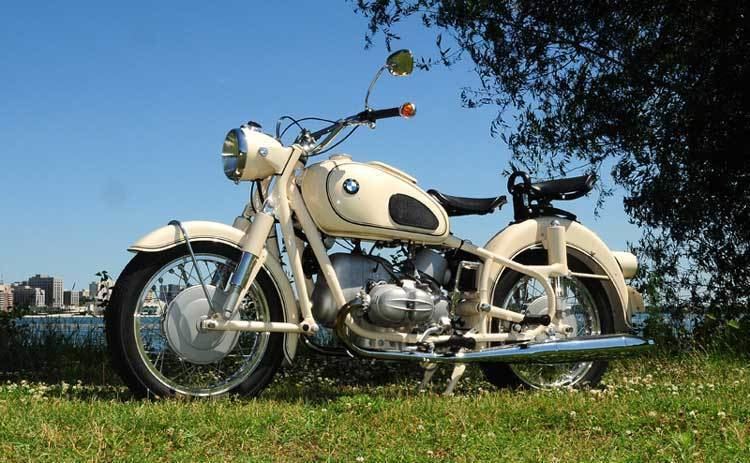The R69S, R69US, and R69 are motorcycles, fitted with 594 cc boxer twin engines, that were manufactured by BMW in Munich, Germany.
From 1955 to 1969, 15,347 of these 594 cc shaft-drive, opposed twin motorcycles were built. The 35 hp (26 kW) R69 was produced from 1955 to 1960, the 42 hp (31 kW) R69S was produced from 1960 to 1969, and the 42 hp R69US was produced from 1968 to 1969. These models were designed as relatively high powered, high compression sport bikes, although the Earles fork R69 and R69S came with sidecar lugs installed on the frames. These lugs were deleted from the telescopic fork "US" models. The low compression 30 hp (22 kW) R60/2, produced from 1955 to 1960, was designed primarily for sidecar use, though it was popularly used as a solo bike, along with the 30 hp R60US, which was produced between 1968 and 1969.
The sport-oriented R69S, R69US, and R69 succeeded the plunger-framed 1951 to 1955 R68, which had an engine very similar to that in the later R69.
The R69US models, with telescopic forks, which were used later on the BMW R-/5 series motorcycles, were introduced in the United States for the 1968 model year and then continued for 1969. Front and rear side reflectors, demanded by the U. S. Department of Transportation, were introduced only for the 1969 model year, along with a DOT sticker that was placed on the rear fender. The previous Earles fork continued to be offered during these years.
In June 1962, Cycle World magazine published a review of the R69S. Its initial and concluding paragraphs read:
R69S Specifications. (R69 specifications shown in parentheses when different from the R69S)
Start of Production — 1960 (1955)End of Production — 1969 (1960)Numbers Produced — 11,317 (2,956)Internal Designation — 268/3 (268/2)Motor Type — Four-stroke two cylinder flat twinBore × Stroke — 72 mm × 73 mm (2.83 in × 2.87 in)Displacement — 594 ccMax Power — 42 hp (31 kW) at 7000 rpm (35 hp or 26 kW at 6800 rpm)Compression Ratio — 9.5:1 (7.5:1)Valves — OHVCarburation System — 2 carburetors, Type Bing 1/26/75-1/26/76 or 1/26/91-1/26/92 (1/26/9-1/26/10)Engine Lubricating System — Forced feed lubricationOil Pump — Gear pumpClutch — Single plate, saucer spring, dryNumber of Gears — 4Shifting — Foot shiftingGearbox Ratios — 4.17/2.73/1.94/1.54 (5.33/3.02/2/04/1.54)Rear Wheel Ratio — 1:3.375 or 1:3.13; with sidecar 1:4.33 (1:3.18 or 1:4.25 sidecar)Bevel/Crownwheel — 8/25 or 8/27 teeth; with sidecar 6/26 (11/35; 8/34 sidecar)Ignition System — Magneto ignitionGenerator — Bosch LJ/CGE 60/6/1700 R (Noris L 60/6/1500L)Spark Plugs — Bosch W260T1 or Beru 260/14 (Bosch W240T1)Designation — 245/2 (245/1)Frame — Double loop steel tubular frameFront wheel suspension — Earles fork with suspension units and oil pressure shock absorbersRear wheel suspension — Long swing arm with suspension units and oil pressure shock absorbersWheel rims — Deep bed 2.15B × 18; with sidecar, rear 2.75C × 18Tires, Front — 3.5 × 18 STires, Rear — 3.50 S (4 × 18 S with sidecar)Brakes, Front — Drum brake 200 mm (7.9 in) diameter duplex full hubBrakes, Rear — Drum brake 200 mm (7.9 in) diameter simplex full hubLength × Width × Height — 2125 mm × 722 mm × 980 mm; (83.66 in × 28.42 in × 38.58 in)Wheel Base — 1415 mm (55.7 in); with original sidecar 1450 mm (57.1 in)Fuel Tank Capacity — 17 l (3.73 imp or 4.49 US gal)Unladen Weight with Full Tank — 202 kg (445 lb); with original sidecar 324 kg (714 lb)Idle/Riding Noise — 84/82 DIN phon; from 13 September 1966: 78/84 dB(A)Load Rating — 360 kg (790 lb); with original sidecar 600 kg (1,300 lb)Fuel Consumption — 5.3 liters/100 km / 44 mpg (US) (3.6 l/100 km or 64 mpg (US))Oil Consumption — 0.5 - 1 liters/1,000 km approx.Top Speed — 175 km/h (109 mph) (165 km/h or 103 mph)
